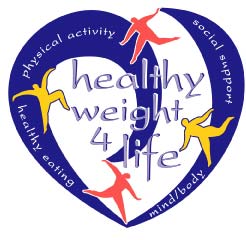|
Healthy weight 4 life |
|
|
Research program helps women drop pounds, change their lives By Susan McGinley
|
|
|
|
Fad weight loss programs often focus on just one strategy—restricting carbohydrates, for example, or drinking a special shake, or working out on one special machine. In this one-size-fits-all approach, pounds lost initially may pile back on as rebellion or boredom sets in. A research-based weight control program underway at the University
of Arizona combines several strategies, tailoring choices in diet, exercise,
counseling, and social support to help each participant (women aged
40 to 55) find her way to a healthy weight. Since “Healthy Weight
4 Life” began in fall, 2000, more than 150 women have lost an average
of 10 pounds, and kept it off during an 18-week follow-up period. Some
have lost as much as 50 pounds. The program is funded by the National
Institute for Diabetes, Digestive and Kidney Diseases. “This is not an innovative weight loss plan in terms of content,
but it is innovative in the way we put it together,” says Scott
Going, an associate professor in the Department of Nutritional Sciences.
“There is a critical need for effective weight management programs
that integrate all the factors that contribute to excess weight. Overweight
and obesity affect more than 50 percent of the U.S. population, according
to recent figures from the Centers for Disease Control.” Going believes a university environment is the ideal place to develop
multi-disciplinary, collaborative approaches to weight loss that combine
research and community outreach. He is working with a multi-disciplinary
team of researchers from the College of Agriculture and Life Sciences
and the College of Medicine to develop and test a sound, scientifically-based
weight loss program. The two-phase program, administered through the Department of Nutritional
Sciences and the Department of Physiology begins with a 16-week weight
loss curriculum emphasizing increased physical activity, healthy eating,
social support and the “mind-body” connection. “We promote
slow weight loss: a pound a week,” Going says. “Key behaviors
are diet and physical activity. Everything else we do supports that.
Our goal over 16 weeks is to give participants the information they
need, increase their awareness of behaviors contributing to excess weight,
get them to try a lot of different activities, and figure out what works
for them.” Components in the first phase include: |
 USDA Food Guide Pyramid |
|
|
|
So far, more than 90 percent of the women enrolled in the online support
phase have maintained their weight or have continued to lose more weight.
Some of the women in the program bordered on class II obesity when they
started. In the future, with additional funding, the team hopes to expand
the program and test the Internet against other strategies for long-term
support for weight loss. Although “Healthy Weight 4 Life” was begun as a study, the researchers are pleased that so many people have changed their lives as a result of the program. “After a while these strategies become second nature to you; you want to do them,” Going says. “Many of the participants have gotten their boyfriends and husbands exercising, and they’re losing weight, too.”
|
